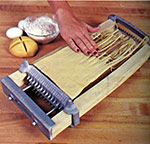Chitarra Pasta Cutter

Display: Global Gastronomy
Culinary Technique: size reduction
Date: 20th Century
Named in Italian for its resemblance to a guitar, a chitarra slices flat sheets of pasta into noodles. The wood and cast aluminum frame holds two sets of steel wires spaced at 1/8-inch intervals on one side and at 1/16 inch on the reverse. Rolled out pasta placed on the strings is pressed by hand or with a rolling pin. A sliding tray between the wires catches the noodles as they are cut so they can be hung to dry. Thinner than extruded noodles, rolled, cut pasta cooks faster and absorbs more sauce. The chitarra originated around 1800 in Italy's Abruzzi region; the Vitantonio Mfg. Co. in Cleveland, Ohio, introduced it to the United States in 1906.




